Musings

Tomorrow is Valentine’s Day. If you haven’t gotten your wife, fiancée, or girlfriend something, you have less than 24 hours to get something. Good luck on such short time constraints.
Now, if you didn’t send the woman in your life something yesterday, you still have time to do something special. At least from my experience, my wife loves getting flowers at work. It’s a bigger deal around Valentine’s Day because there is usually a parade of flowers coming into the office. You don’t want your significant other to be the person that received nothing:
Luckily, with Valentine’s Day being on a Sunday, you have an out. You can have flowers sent on Monday and pretend it was the plan all along.
Now, I know the main issue with sending flowers this time of year. It’s incredibly expensive. It’s more expensive having them delivered. The price will go up when you consider you’re ordering them at the last minute. There’s a way to dramatically reduce the cost.
Go pick up the flowers yourself. You can get them from a florist or a grocery store. By picking them out yourself, you have the added benefit of making sure the flowers are in good shape. Trust me, these places will send out whatever they have in stock. The only thing worse than sending nothing is sending out garbage. Sending nothing means you forgot. Sending awful flowers embarrasses her. This prevents that.
Once you have the flowers,drive to your significant other’s job and drop it off at the front desk or security. They will deliver the flowers to your significant other’s desk. Trust me. It will have the same effect as the flowers being delivered by a florist or 1-800 Flowers. Remember, the idea is not to spend a lot of money. The idea is to make her happy.
I hope this helps. Good luck and enjoy your Valentine’s Day.
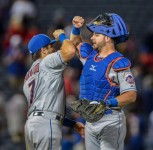
While the Mets have issues regarding their ability to extend their starting pitching, they have other areas to address as well. As it stands, the Mets may have around $97 million off the books by 2019. The Mets will need that money not just to re-sign pitching, but also to build their roster.
One key decision the Mets will have to make is at catcher. By 2019, Travis d’Arnaud will be a year away from free agency. Kevin Plawecki will be in either his first or second arbitration year around the same time.
As it stands going into the 2016 season, the team is best suited to have d’Arnaud starting with Plawecki as his backup. However, I do question if that arrangement is the best situation for the long term. It can be argued with the Mets going into this season with that arrangement, they risk the diminution of the trade value of either or both of these players. It’s a tough decision to make.
Travis d’Arnaud
d’Arnaud is a 27 year old catcher, who is presumably entering the prime of his career. He will be 31 when he becomes a free agent, assuming the Mets don’t work out an extension with him before that.
After working out his game in AAA in 2014, he seems to have fulfilled his offensive potential. When he returned, he hit .272/.319/.486 with 10 homers and 32 RBI in 69 games. He had a low BABIP of .287, which showed these numbers could get even better. They did in 2015. He hit .268/.340/.485 with 12 homeruns and 41 RBI in 67 games last year. He again had a low BABIP of .289. So there may still be room for improvement (assuming of course that the .287 – .289 BABIP is his natural level).
On top of these good and improving numbers, d’Arnaud has shown himself to be a good catcher. He was a highly rated pitch framer in 2014, and he was again in 2015. It’s important to get those extra strike calls to help reduce the pitches thrown by your pitching staff. In fact, d’Arnaud was the best at it last year. Despite his troubles in the World Series, d’Arnaud had an acceptable 32.6% rate of throwing out would be basestealers.
I understand there is more to catching than this, however the other things involved like blocking pitches in the dirt aren’t as quantifiable. Regardless, the most important thing for a catcher is to be a good receiver, and d’Arnaud has seemingly and statistically fine very well in that area.
Between d’Arnaud’s offensive and defensive abilities, you’d be hard pressed to find a reason not to extend d’Arnaud.
Unfortunately, there is a reason. Whether it’s fair or not, d’Arnaud is getting a reputation as injury prone. Last year, d’Arnaud had two freak contact injuries. In April, he broke his pinkie when he was hit by a pitch. When he returned from the DL, he suffered a hyper-extended elbow on a tag play. If that was it, I presume most teams would chalk it up to the freak nature of those injuries. However, he also had a number of injuries in the minors.
This year will be a big year for d’Arnaud. If he stays healthy, he’s primed for a big year; the type of year that will get him paid well in arbitration and free agency. If he gets injured again, he gives validity to the injury prone label thereby diminishing his arbitration and trade value.
Kevin Plawecki
Coming into the 2015 season, Plawecki was a well regarded prospect. Reflecting upon Plawecki’s 2015 season, it’s strange to think he was a highly regarded prospect more because of his bat than his glove.
Like d’Arnaud, Plawecki was exceptional in pitch framing last year. In fact, among big league catchers last year, he was second best. He was not as adept as d’Arnaud in throwing out baserunners. He only threw out 25.6% of basestealers. Given his needing to work on his footwork behind the plate, this should not come as a surprise. Unfortunately, the Mets losing Bob Geren is a hindrance because Geren was well regarded in his ability to work with catchers. That’s not to say Plawecki can’t improve.
Offensively, Plawecki is a different hitter than d’Arnaud. Whereas d’Arnaud has been seen as a power threat, Plawecki is seen as a gap to gap hitter. His offensive game was thought to be so advanced it was thought he could challenge d’Arnaud for playing time last year. That never happened. In part, that is because Plawecki had a tough rookie year.
In an admittedly weak Mets lineup, Plawecki hit a woeful .219/.280/.296 in 73 games. One could be further pessimistic about Plawecki’s offensive potential by looking to his AAA numbers. In AAA, in a hitter’s league, Plawecki only hit .262/.318/.392 over parts of two seasons. However, that’s not the full picture of Plawecki offensively.
Keep in mind, Plawecki only played 65 games in AAA, which is not a full season. Over the course of his minor league career, Plawecki was a much more palatable .290/.364/.432 hitter. Furthermore, while Plawecki’s major league numbers were lackluster, he had a low .277 BABIP. This suggests he’s due for an improvement at the plate next year. Overall, given how well regarded a prospect he is, it would be fair to presume Plawecki could be much better offensively next year.
We also don’t know what, if any effect, Plawecki’s sinus problems had last year. Plawecki admitted he felt dizzy during parts of last season. With his offseason surgery, and a year in the majors under his belt, Plawecki could be due for a much improved 2016.
The main thing holding him back will be d’Arnaud. As d’Arnaud’s backup, Plawecki will get limited reps at the plate hindering his ability to improve. Furthermore, with reduced playing time, Plawecki’s numbers can swing drastically. He’s as likely to have good numbers as he is to have poor numbers. Whichever way it goes, it’s likely to be a small sample size. With that said, if he has another poor offensive season, whether it’s driven by a low BABIP or not, it will be hard to unring that bell.
Another issue is Plawecki’s status as the backup catcher. While it’s understandable the Mets want Plawecki around to play a little more to help keep d’Arnaud healthy, it should be noted that this still makes Plawecki a backup catcher. While his status as a backup catcher will drive down his arbitration numbers, it will also drive down the return you may get for him in a trade.
Why Are They Both on the Roster
Simply put, d’Arnaud and Plawecki are both on the roster because it gives the Mets the best chance to win in 2016. The hope is that Plawecki can catch more frequently than your average backup to keep d’Arnaud fresh and healthy.
In addition, the Mets are contemplating letting both learn other positions to keep them both fresh and get them both enough at bats. It’s more important for Plawecki because he’s still a young prospect who needs at bats. d’Arnaud could also benefit because getting him out from behind the plate should keep him fresh over the course of the year.
As such, the Mets will need both in the majors. If they play it right, they could get good years from both while maintaining or improving their trade value. This could be Terry Collins biggest challenge in 2016.
d’Arnaud’s Potential Contract
Given the expense that will be incurred in locking up the Mets starting pitching, who the Mets keep may be driven by how expensive they will be.
Naturally, d’Arnaud’s value will vary depending upon his health. If d’Arnaud is healthy, the comp I would use for his contract is Russell Martin. When Martin signed his most recent free agent deal with the Blue Jays, he was coming off a career year where he hit .290/.402/.430. With that’s said, Martin was a career .259/.364/.399 hitter, and he was coming off his age 31 season. That is how old d’Arnaud will be when he becomes a free agent.
Now, d’Arnaud has hit for more power than Martin. However, Martin is more durable, and he has been seen as a leader. Martin has averaged 129 games behind the plate. d’Arnaud has not caught more than 108 in a season. However, assuming d’Anaud is healthy, you would envision him being a catcher who is comparable to Russell Martin, if not better. Accepting that premise, here is the breakdown of Martin’s contract:
- 2015: $7 million
- 2016: $15 million
- 2017: $20 million
- 2018: $20 million
- 2019: $20 million
Now, I’m not suggesting the Mets would or should give d’Arnaud a five year $82 million contract. Martin was a free agent, who could’ve signed with anyone. d’Arnaud loses some bargaining power by being arbitration eligible. If the Mets sought to enter into a deal with him, buying out some free agent years, his contract could reasonably look like this:
- 2018: $8 million – $10 million
- 2019: $10 million – $15 million
- 2020: $15 million – $20 million
- 2021: $15 million – $20 million
Assuming this is a fair and reasonable range, the Mets available money, assuming no increase in the payroll, would be between $82 million to $87 million to complete the roster.
Plawecki’s Cost
While d’Arnaud may cost the Mets between $10 – $20 million, Plawecki should cost less. If Plawecki remains with the club for all of 2016, he will likely become a Super Two player (assuming no changes to the CBA). As such, Plawecki would become arbitration eligible in 2019.
Now, if the Mets were smart about tinkering Plawecki’s service time, they could delay his arbitration eligibility until 2020. That would mean in 2019, the Mets would only need to pay him approximately $500-$600 thousand leaving the bulk of the $97 million to pay their starters and fill out the roster.
With that said, if you’re going to keep Plawecki, and make him the starter, you’re going to have to pay him eventually. Judging by typical arbitration figures, Plawecki could earn anywhere from $1 million to $5 million depending on playing time and production. If Plawecki becomes the starting catcher, and he’s productive, he would be at the higher end of the spectrum.
Depending on the decision the Mets make on Plawecki, that $97 million figure could be reduced to the range of $92 – $96 million.
The Decision
Selecting between d’Arnaud and Plawecki is no easy task. While d’Arnaud is more polished offensively and defensively, he is also three years older, and he has a long injury history. He is going to be a lot more expensive than Plawecki at the time the Mets starting pitchers will become free agents.
On the other hand, Plawecki is a well regarded prospect that has yet to produce in AAA or the majors. There is still time for him to fulfill his potential. However, that will be difficult with the Mets keeping him on as a backup limiting his at bats. The best course would be for the Mets to put him in AAA, manipulate his service time, and let him improve. It appears the Mets won’t do that.
No matter what the Mets do, the time to make the decision between d’Arnaud and Plawecki is fast approaching. Sooner or later, the Mets will have to choose between the two. In terms of preserving trade value that decision could be in 2016 or 2017, at the latest. In terms of cost, it appears 2019 is the last date. It would behoove the Mets to make the decision sooner rather than later to maximize the return they would get for either player.
Overall, while he may be much more expensive, and therefore a possible hindrance to re-signing a starter, I would keep d’Arnaud. He’s already shown himself to be an offensive force while being a good receiver. He’s a better bet to produce going forward than Plawecki.
Hopefully, he’s healthy enough to justify an extension, and Plawecki improves enough to become a big trade chip. Ultimately, that is the best case scenario for the Mets going forward.
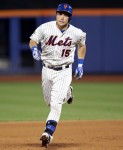
For one reason or another, Travis d’Arnaud switched uniform numbers with bench coach Bob Geren heading into the 2015 season. Now that Bob Geren has left the Mets for the Dodgers, the Mets should not give out the number 15 again.
It’s what the Mets have traditionally done with numbers they have anticipated they will retire. After Tom Seaver was traded to the Reds, no other Met would wear the number 41. After Mike Piazza left the Mets as a free agent, the Mets never re-issued 31. These were two future Hall of Famers that were expected to enter the Hall of Fame as a Met. These are the only players to have their numbers retired by the team. With them, the Mets have created the standard that they will retire the numbers of players that have entered the Hall of Fame as a Met.
With Carlos Beltran announcing he may retire after this year, the Mets should give him similar treatment.
Beltran is coming to the end of a terrific career, one that is certainly worthy of the Hall of Fame. Right now, it appears it’ll be up to Beltran as to whether he enters the Hall as a Met, Royal, or a blank cap. For what it’s worth, Beltran has said that if he receives the honor, it’s possible he could enter the Hall of Fame as a Met. If so, the Mets should effectively retire the number now instead of handing it out to the Fred Lewises and Val Pascuccis of the world. Looking at the Mets current roster, the number hasn’t been assigned. The players without designated numbers aren’t players of Beltran’s caliber.
d’Arnaud should be the last Met to ever wear the number 15. Hopefully, one day the Mets can retire the number 15. Even better, it would be great to retire number 7 for d’Arnaud.
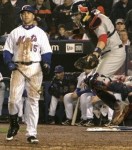
According to WAR, Carlos Beltran is the sixth best Met of all-time. He’s higher ranked than recent Hall of Fame inductee Mike Piazza. He’s a future Hall of Famer. The end of his Mets tenure was the beginning of Terry Collins tenure. When Beltran speaks, he deserves your full attention.
With that said, a person should always pick their spots when to interject an opinion. In his interview with George A. King, III, Beltran offered his opinions on Terry Collins sending Matt Harvey out for the ninth in Game 5 of the World Series. Collins’ decision ranks right up there with Grady Little leaving Pedro Martinez in during Game 7 of the 2003 ALCS. It’ll be talked about for generations. Everyone will have a perspective. For what it’s worth, here was Beltran’s take on Collins sending Harvey back out there:
He was looking down and I felt that he wanted to take Harvey out. But at the same time, Harvey was pitching such a good game and Harvey wanted that moment. He went with what Harvey showed him and not what he was thinking. That’s an experience for him. Later on [taking Harvey out] will happen. He will say,’My friend, I will give you a kiss of I have to, but I have to get my closer.’ It was a bad decision to leave him in, but in his heart I felt that he wanted to make a different move.
It’s a fine and reasonable take, but man, I really don’t want to hear Beltran talking about decision that lead to the end of playoff series. Much like the end of the 2015 World Series, his strikeout at the end of the 2006 NLCS will forever haunt Mets fans. For his part, Beltran said he couldn’t do anything with the pitch. To be fair, it was filthy:
However, with that said, he didn’t try to foul it off. He didn’t try to make a fielder make a play. There would be no little groundball up the first baseline. No, Beltran was beat, and he didn’t go down swinging. This doesn’t change the fact that he was a great Met. It doesn’t mean he shouldn’t be a Hall of Famer. It doesn’t even mean his opinion on Collins sending Harvey back out there was wrong.
No, it just means that when it comes to series altering decisions, Beltran’s opinion is the last one I want to hear.
Editor’s Note: this was first published on metsmerized.com

Last year, I made sure to bring my son to Steven Matz‘s first start. I wanted him to be there to see what we all presumed was the last installment of what was to be a Mets super staff.
It was a great day. Matz allowed only two runs over 7.2 innings. He went 3-3 at the plate with four RBI. It was such an amazing first start that his celebrating grandfather became a legend in his own right:
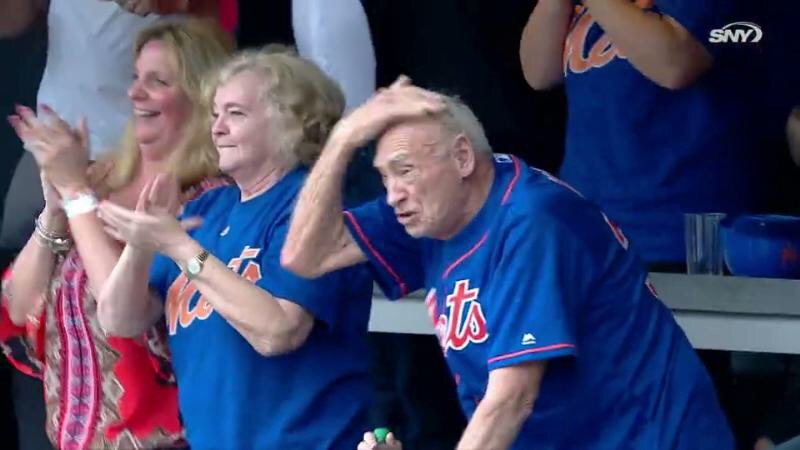
Matz followed that up with a terrific start in Los Angeles allowing no runs over 6.0 innings recording eight strikeouts. After that, Matz was shut down with an torn oblique that Dan Warthen checked out himself before the Dodger start.
He would’ve pitch again for another two months. He came back, and he went 2-0 with a 2.86 ERA in four starts. However, those numbers seem better than he pitched. In those four starts, batters hit .297/.330/.374 against him. He has a 1.45 WHIP. He would then have a back injury. This injury would not prevent him from being named to the postseason roster.
Matz wasn’t great in the postseason. He was 0-1 with a 3.68 ERA. He pitched into the sixth inning once in his three starts. He had a 1.432 WHIP.
What can we glean from all of this? Absolutely nothing. Matz’s first two starts were exciting, but they were only two starts. The four starts at the end of the season were after two months of complete inactivity. His postseason starts came more than two weeks after his last regular season start. His second postseason start came eight days later. His World Series start was 10 days later. He wasn’t getting enough work to stay sharp.
As of today, he’s probably a favorite to be the National League Rookie of the Year. Most Mets fans expect him to be an ace. I think that’s not fair. Matz hasn’t showed himself to be that good yet. The projections for him aren’t that rosy.
I don’t know what’s driving those numbers. I don’t know if his injuries last year are driving those low innings projections. It could be his two injuries last year.
I’m not sure how it is to presume Matz is injury prone. While he did have two freak injuries last year, it’s not fair to say he’s injury prone. So far, all we have is the two injuries this year and a longer than usual rehab from Tommy John surgery. So while I’m sure the Mets will have an eye on his innings pitched, I also believe, he has a reasonable chance to be healthy for a full season.
The next issue is why do the projections see Matz having such a high ERA next year. My presumption is that this is based on Matz’s 3.61 FIP last year. Based upon his FIP numbers, the projected ERAs are certainly justifiable. However, again, four of those starts were made after Matz had no baseball activities for two months due to his lat injury.
We all have hope Matz will be great in 2016. However, there is nothing from his 2015 season that can establish he will be good or bad next year. Whatever happens, I’m going to enjoy the ride.

During Jeurys Familia‘s time answering questions on the Mets Twitter account, the dumbest baseball argument was resurrected:
A sandwich is a sandwich, a hot dog is a hot dog! #AskFamilia https://t.co/rht7efanCs
— New York Mets (@Mets) February 9, 2016
Sigh.
I guess it’s a sign that the Mets are in such good shape for the upcoming season that we’re back to arguing about whether or not a hot dog is a sandwich.
Alright, let’s start with the basics. It should be fair to say that most people do not believe they are ordering a sandwich when they are ordering a hot dog at a game. However, there’s no reason why that should be dispositive. For example, most people, the State of New Jersey, and the Supreme Court believe a tomato to be a vegetable. It’s not. A tomato is a fruit. No matter how you argue it, it’s a fruit.
Now, I bring this up because there are many arguments on the tomato. The arguments are similar. It’s a gut feeling, or wanting to tax an item, that is the driving force. If you want to rely upon tax codes and the Supreme Court, I refer you to the New York State Department of Taxation and Finance who clearly defines a hot dog in a bun as a sandwich.
Personally, I wouldn’t want to rely on that. Tax codes and the like aren’t written to be correct. Rather, they are written to exact as much revenue as possible. So let’s try another route.
The dictionary definition of a sandwich is two or more slices of bread, or a split roll, with a filling. So yes, under the dictionary definition, a hot dog on a roll is a sandwich. It’s a position food experts seem to share:
— Alton Brown (@altonbrown) February 4, 2016
I’ve heard all the contrary opinions. When you order a sandwich, you’re not expecting a hot dog. Maybe, but when I order peanut butter and jelly, I’m expecting that to be on bread.
When you go to a game and order a hot dog, you expect to get a hot dog on a bun. True, but when your spouse tells you to get hot dogs from the grocery store, do you bring them home already cooked and in buns, or do you purchase them separately?
Look, it’s not a sandwich, it’s just a hot dog. To me this is an argument that just seeks to prove its underlying point. It’s like saying Lucas Duda isn’t a good first baseman because of one throw while ignoring his 57 homers in two years.
So overall, whether we like it or not, a hot dog on a bun is a sandwich. Now, can we please move onto more important topics like who will pitch the sixth inning for the Mets this year?
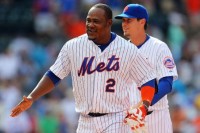
Families and friends will gather around the TV tonight to watch the Super Bowl tonight. Some gather for the game. Some gather for the commercials. With some Mets already at Spring Training, I’m sure they’ll get together to watch the game.
One person we know who will not be there is Juan Uribe. No, not because he’s a free agent. He’s not watching because he really hates football. He only wants to watch baseball. If he was there tonight, he’d probably tell David Wright to turn on the baseball game. Unfortunately for Uribe, there’s no baseball games being televised during the Super Bowl tomorrow. No, not even on the MLB Network.
So who knows? Maybe Uribe breaks down and watches the Super Bowl tonight. If it’ll help him to know that Cam Newton loves baseball or that his former teammate Todd Helton was a former teammate of Peyton Manning at Tennessee.
In any event, after tonight, it’s all about baseball just like Juan Uribe wants it to be.
My favorite Mets jerseys are the ’86 Mets jerseys. I love the orange and blue racing stripes along the sides of the jerseys. Now that the Mets are celebrating the 30th anniversary of the ’86 World Series title, the jersey is coming back:
Mets will wear '86 uniforms multiple times throughout the season as an alternate — not just during weekend honoring 30th anniversary.
— Adam Rubin (@AdamRubinMedia) February 3, 2016
At first, I was ecstatic. I never thought the Mets should’ve gotten rid of those jerseys. I love seeing them out on the field. It reminds me of a time when the Mets were great. It reminds me of when the Mets once owned New York. Those days are long past. The Mets have moved on from that time.
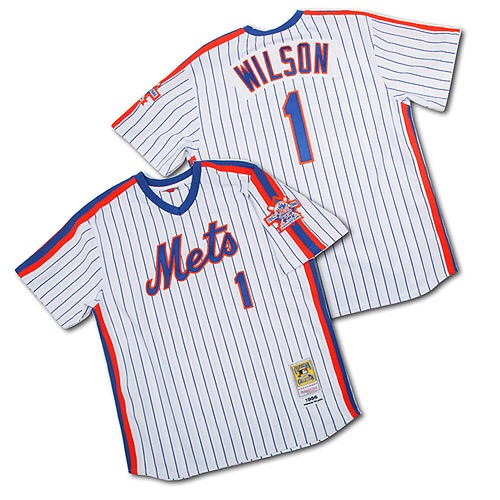
First, it was the black jerseys. They had a good run through the 90’s. Then it was a transitional period where we saw less of the black, more of the snow white jerseys, and variations of the pinstriped jerseys.
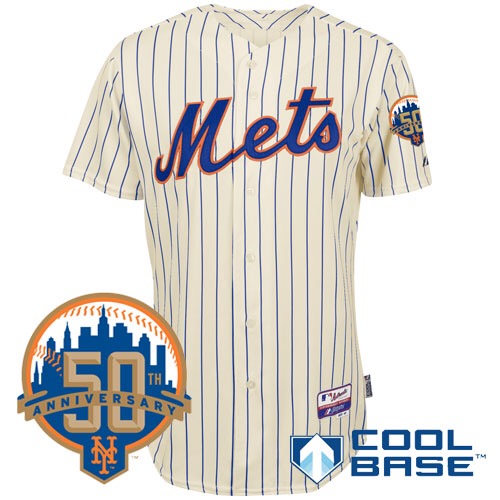
Now, the Mets have settled on a new group of uniforms. It’s a mixture between the simpler old-style uniforms and the nice alternate blue uniforms.
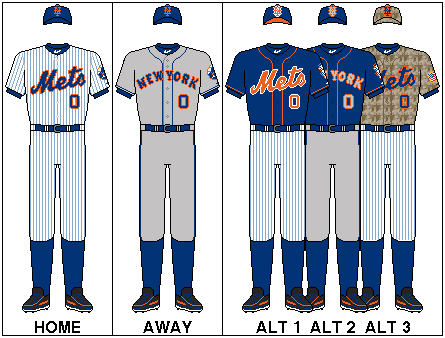
These are new uniforms for a new generation of Mets baseball. While I agree the Mets should be wearing the ’86 jerseys to celebrate the last Mets World Series championship team, I do not agree they should be worn throughout the season. Instead, I’d like to see the Mets update the patch the Mets wore on the ’86 jerseys.
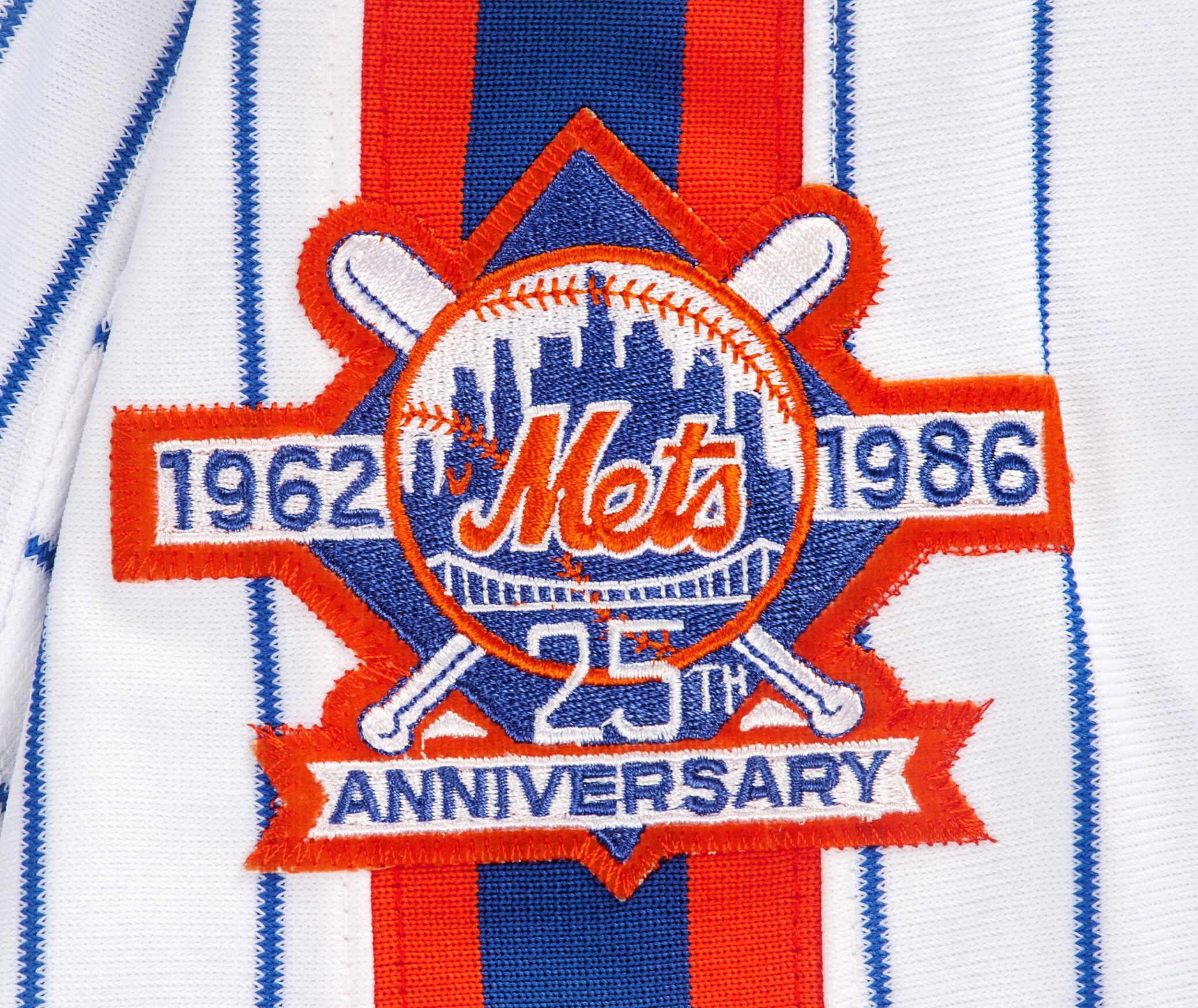
Recreate this patch with the years 1986 and 2016 for the 30th anniversary. Put these on the new Mets uniforms. The uniforms that belong to the ’16 Mets. Let these Mets wear their own uniforms.
Hopefully, they will be the same uniforms another Mets team will wear 30 years from now.
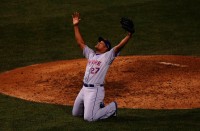
Last year, the Mets were carried by their pitching. It helped them sustain an anemic offense until the Mets got healthy and made trades. It helped carry them to the World Series. It’s the promise for the future.
That future first comes into question around 2019. That is the year that Matt Harvey becomes a free agent. Zack Wheeler could become a free agent the same year or the subsequent year. Two years later Jacob deGrom becomes a free agent. After that, the Mets will have to address the free agent case of Noah Syndergaard and Steven Matz. Naturally, this prompts the discussion of who the Mets should extend and when they should do it.
When these discussions take place, I find everyone to be extremely short-sided. Yes, it’s important to make a decision on the Mets starters, especially on Harvey, deGrom, and Syndergaard. However, I find that these discussions ignore Jeurys Familia. Like Harvey, Familia will be a free agent in 2019.
Familia was an exceedingly important part of the 2015 Mets. He was the stabilizing force at the back-end of a beleaguered bullpen. During 2015, Familia had the fifth most appearances. Of players who were strictly relievers, he had the third most innings pitched. He lead the league in games finished. He tied the Mets single season record for saves.
The advanced statistics also loved Familia’s 2015 season. He had an ERA+ of 200, which is astounding. It was the best amongst Mets pitchers. In fact, it’s a tick below Mariano Rivera‘s career 205 mark, which is the best in major league history. Familia’s FIP was 2.74, which, unsurprisingly, rates him as an excellent pitcher. Mariano’s career mark was 2.76. In essence, Familia’s 2015 was Riveraesque.
Keep in mind, Collins initially deployed Familia like Rivera. When it came time to close out the NLDS, Familia pitched two shutout innings. In the whole postseason, Familia had 12 appearances, and of those 12 appearances, he pitched more than one inning five times. He pitched 14.2 innings in those 12 appearances. Yes, he blew three saves in the World Series, but he only allowed one earned run the entire postseason. In reality, the blown saves were not on Familia but the Mets team as a whole.
Its important to lock-up some starting pitchers. If Harvey, deGrom, or Syndergaard leave, the Mets have other starters to keep having a strong rotation. If Familia were to leave, the Mets do not appear to have another reliever to take Familia’s spot. This makes extending Familia absolutely imperative.
So when it comes down to which Mets pitcher I would extend first, my answer is Jeurys Familia.
Editor’s Note: this article also appeared on metsmerizedonline.com
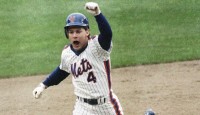
This is a whole new generation. When I was growing up, we had candy cigarettes (gone) and Big League Chew (still around). While playing baseball, we used to have the candy cigarettes so we could smoke like Keith Hernandez, or we would shove a ton of Big League Chew in our mouths to look like Lenny Dykstra. Dykstra was such a legendary chewer that he was said to have stained the AstroTurf at the old Vet.
As kids, we used this stuff because we thought it was cool to look like ballplayers. Did we try to real stuff? Well, not as kids. It’s s good thing too because it would’ve been like that scene in The Sandlot:
https://m.youtube.com/watch?v=CAxuXNxsNMk
Personally, I never really had any interest. Part of the reason was my parents. Another part was I was a catcher. I’ve seen catchers who have used chewing tobacco, but to me that was a pain. I tried seeds, which is similar in principle, but it annoyed me. So I went without any of it for most of my baseball life.
Then I got older, got big, and was moved out from behind the plate. Part of “rookie” hazing was getting them to throw in a dip and watch the hilarity ensue. It wasn’t pleasant.
In any event, I found myself playing that dreaded DH position more and more, which means you spend a lot of time on the bench. Many of those guys throw one in, so you usually do as well. You practice that finger motion with your index finger so you can pack it better and tighter. One day, it all becomes second nature.
When I was in college, it was great. There were a couple of nights, it helped me get through the all-nighters. Also, there were some bars in the area where if you didn’t throw one in, you were out of place. Honestly, I wasn’t so much addicted to it as I loved doing it.
A good friend of mine and me used to love dipping while watching baseball games. We would not only watch the games, but we would also keep an eye out for who was dipping. You would see the finger going in the dugout. The circle shape in the player’s uniform pants. That ever so slight bump in the bottom lip. If you ever saw it in the top lip, you knew that guy was having real problems. Looking at the Mets now, I can tell you who does and who doesn’t dip. I can do that for any team if I watch them long enough.
Eventually, I quit. It really is a nasty habit. More importantly, it’s dangerous. We saw Tony Gwynn die too young because of it. We saw Curt Schilling battle cancer. As much as I enjoyed it, it really wasn’t worth it.
The strange part is I never would’ve started had it not been part of baseball’s culture. No sport is as associated with smokeless tobacco than baseball. I thought about all of this when I saw Tim Rohan’s New York Times article about New York City looking to ban smokeless tobacco from being used in places like Citi Field and Yankee Stadium.
There’s a lively debate to be had here about whether this law is a good idea or not. It’s a debate that should occur. However, at the end of the day, I’m more concerned for that two year old of mine that loves baseball. I realize that NYC can put every law in place they want, but it won’t matter. It doesn’t matter because the problem is baseball.
The city bans smoking, but we hear about Yoenis Cespedes smoking between innings. We see players using smokeless tobacco all over the field. As we see with Cespedes, a player will find a work-around. You should hear how they work around smokeless tobacco bans and stigmas in other sports. Overall, players will always find a way to do it.
If that’s the case, it’ll always be associated with baseball, and that’s not a good thing. Baseball needs to help find a reasonable solution to this because what they have so far isn’t working. They need to figure it out because one day that Big League Chew becomes Skoal or Red Man. That needs to stop before another generation of players starts using it.
I don’t want to see another Tony Gwynn.